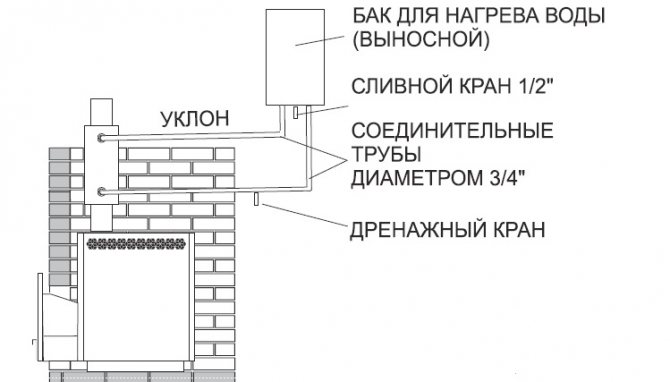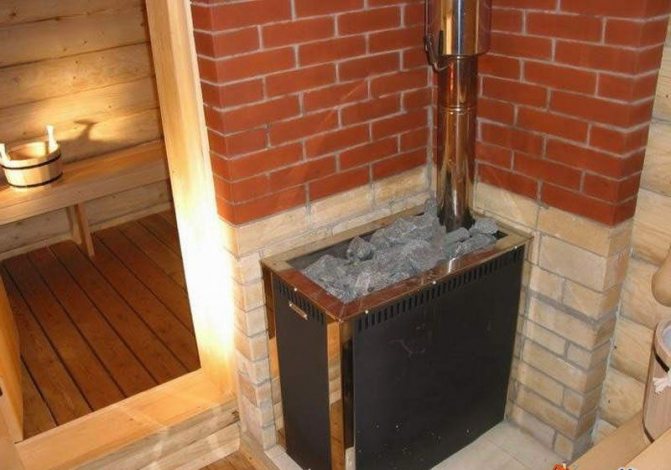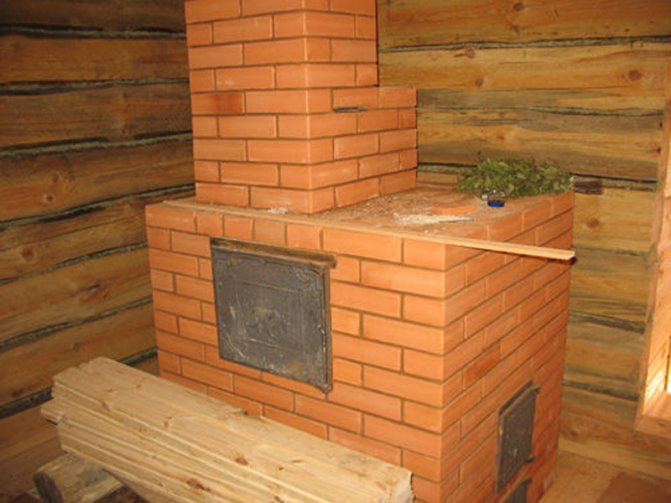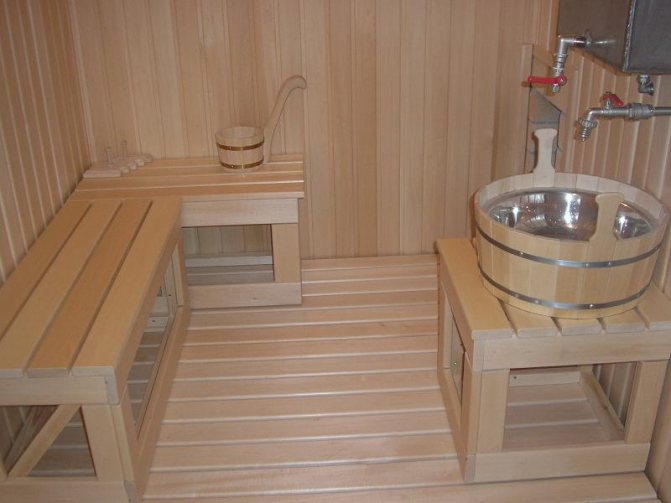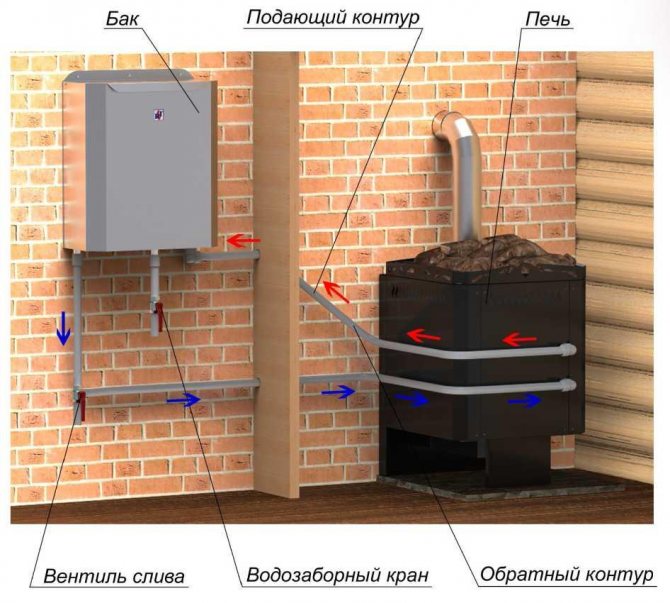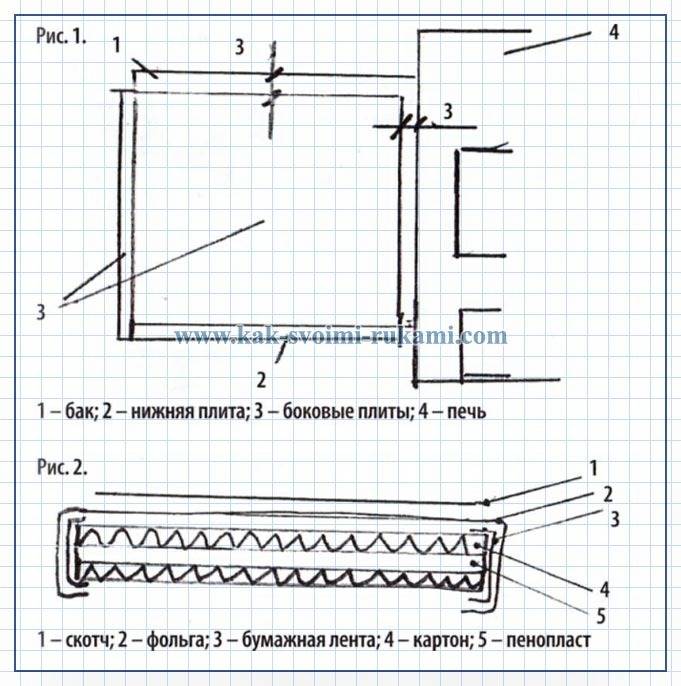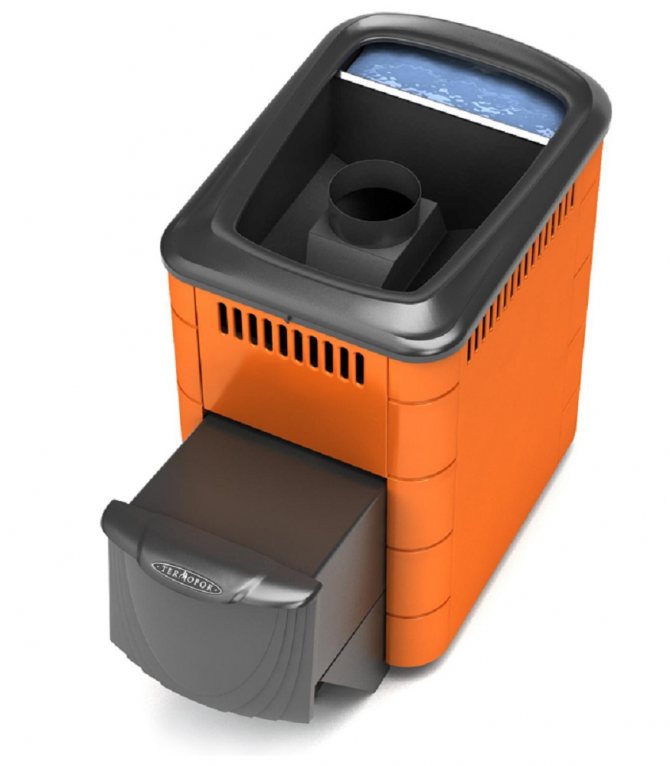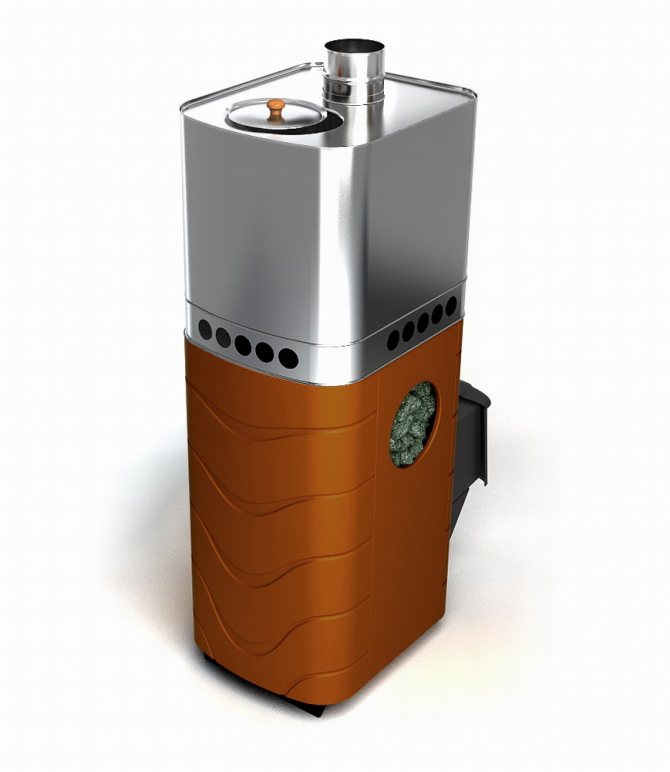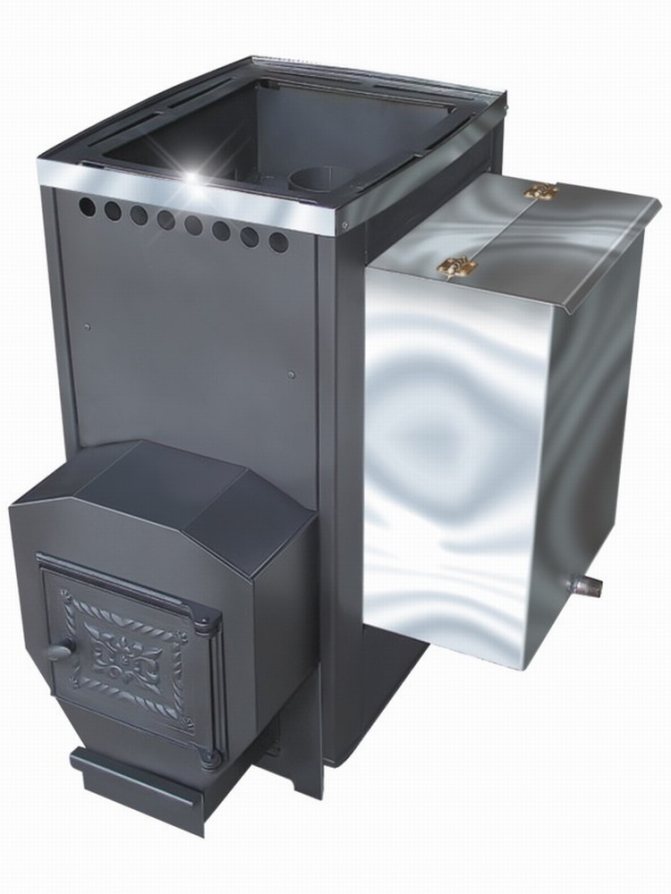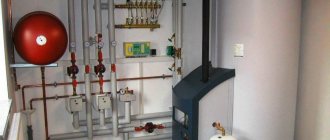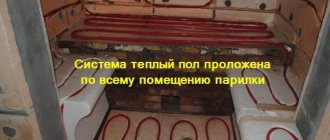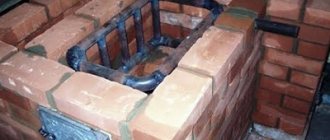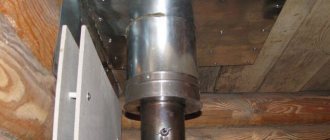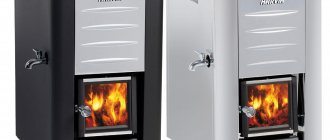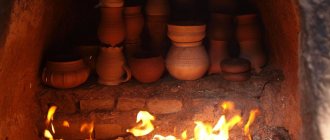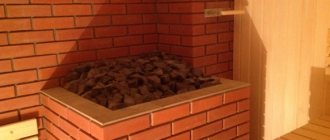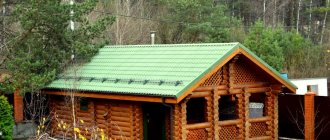Furnace installation
It is easier to use a hinged tank. For its assembly, installation you need:
- Make a box from metal sheets 2-3 mm thick. Weld the individual parts.
- Cut a hole in the upper part of the box for filling the liquid. Make a hole in the lower part, install a tap. This is necessary in order to use liquid or drain it from the tank.
- Attach metal hooks to the side of the plate.
- Weld two labels to the tank, for which it will be hung on hooks.
The optimal amount of liquid for one person is 15 liters.
Even after connecting the water supply system to the bath, questions will arise about how to heat the water. To do this, there are several ways, each of which has certain characteristics, suitable for different types of baths.
November 2, 2015
If a sauna stove with a heat exchanger is installed in the steam room, then there will be no need to spend additional funds on the installation of a boiler, which is required to heat water. Such designs are the most optimal options, due to the fact that they not only heat the room, but also provide the owners with hot water.
If you decide to install a stove for a bath with a heat exchanger, then you need to get acquainted with the principle of operation of this device first. Heat exchangers are also called water circuits. Regardless of where they are located, their functioning is based on the same principle. The heat energy from the furnace goes to the jacket or to the register.
The heat carrier, which is in the heat exchanger, begins to heat up. The water in the tank has a temperature below room temperature or slightly higher. Due to this difference, pressure arises in the circuit, which promotes the circulation of the coolant. Thus, the heated water enters the tank. From it, the coolant is consumed for hygiene procedures.
After that, the next portion of cold water enters the container. It is transferred to a heat exchanger, where it is subsequently heated. In the event that the system is of a closed type, which implies the operation of the tank as a heating device, then the water should be filled in even before the furnace is ignited.
In this case, the temperature difference can cause deformation and damage to the metal of the heat exchanger. The circulation will continue as long as a sufficiently high temperature is maintained in the structure. If you install a stove for a bath with a heat exchanger, then there will be no need to install a water heater, which is installed in the shower room. Among other things, the owners will not be faced with the question of arranging heat sources in the premises.
If you decide to choose a stove for a bath with a heat exchanger, then it is important to get acquainted with the technology of its installation first. Installation work is carried out after arranging the foundation, which is necessarily poured into the ground by 40 centimeters. The subfloor should rise above ground level, but the subfloor should be guided by this.
If you are making a fireplace stove with a heat exchanger, then the prepared cut blanks, which are cut from a metal sheet, must be fixed by welding. After all the calculations have been made, and you are fully convinced that there are no errors in them, you can assemble the entire system finally.
After final assembly, the system should be checked for strength. In this case, you can use the following technology. The lower pipe must be welded, and then filled with water to the very top. The outlet must be connected to the container.Then compressed air is injected, and the pressure gauge allows you to analyze the pressure.
A water heater for a bath: how to choose and which one is better, an overview of models
Bath water heater
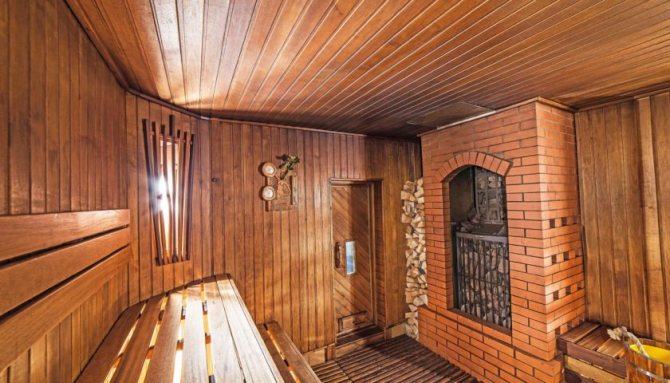
First, it must be as corrosion resistant as possible. After all, the "atmosphere" of the bath is literally oversaturated with water vapor. Therefore, corrosion resistance must be demonstrated not only by the heat exchanger or storage tank, but also by the heater body, as well as all other external and internal metal parts.
Thirdly, it must guarantee the maximum level of fire and general safety.
That is, its design will have to be assembled mainly from non-combustible materials, and it is better to “strengthen” the energy supply lines with additional “fuses” - a residual current device, a flame control system. After all, an ordinary "fire" smoke or flame detector will not work either in the steam room or in the rest room.
Fifth, it can be controlled mechanically, but the presence in the structure of a sensor for controlling the temperature of the supplied water, as well as an indicator of this parameter, is not even discussed.
Yes, almost exactly the same as a standard boiler or a regular column. That is, either a storage tank or a flow-through heat exchanger is "hidden" in the unit's casing. And as a heating element, either a gas burner or a tubular electric heater (TEN) is used.
We offer you to familiarize yourself with the Best stove for a bath rating
However, only gas or electric water heaters for a bath are arranged in a similar way - in fact, the same boilers or water heaters. But wood-burning heaters, which can be found only in the bath, are arranged a little differently.
Such a boiler consists of the following elements:
Heat exchanger installation diagram
In this case, the tank is mounted near the stove (sauna stove), and the register is built into its firebox. Simply put: we have before us a repetition of the scheme of a solid fuel boiler for water heating, heating water by burning wood. Only in this case, hot water flows into a single radiator - a storage tank.
Of course, such a scheme does not allow heating the water to the required temperature, but in a bath this is not the main thing - a medium that is too hot can be diluted with a portion of cold liquid. The truth about the opportunity to take a shower in this case will have to be forgotten. But why do you need a shower in the bath?
Well, the simplest design of a bath water heater is considered to be an ordinary tank with a hatch for filling in water and a fitting with a valve for taking "boiling water". The heating element of such a tank is a metal tube of the heater, which is passed through a container with a heated liquid.
Sauna water heater with water inlet hatch
And according to this principle, everything in the range of heaters can be divided into two groups, namely:
- Flow devices.
- Storage water heaters.
Installation of the first type - an instantaneous water heater for a bathhouse - heats a small volume of water, spending a significant portion of the energy carrier.
This, of course, is not profitable, but in some cases it is very convenient. After all, an electric flow heater can be installed in any bath.
And given the infrequent use, the low energy efficiency of such a device will be practically invisible.
Storage water heaters for a bath - boilers - are beneficial if the device is connected to a low-pressure water supply system, which usually happens in rural areas (including in summer cottages).
They heat up the water and save heat until the right moment.In addition, the cheapest type of water heater - a wood-fired boiler - works only on a cumulative basis.
True, a portion of hot water does not appear in the storage device immediately - it will have to be heated for some time.
Based on the design features and range of water heaters, we can state the following:
- If you do not have gas, then the columns and boilers on this fuel will "pass" by your bath. If you are a happy owner of a gasified bath, then other options can no longer be considered.
- Electric water heaters are expensive, but there are no problems with the installation of the device. It is cut into the water supply and plugged into a power outlet. And that's all - you can use it. Moreover, an electric boiler is a "one-shot" device - this device will prepare the next portion of hot water after 3-4 hours. In addition, instantaneous and storage electric water heaters are afraid of excessive humidity in the bath "atmosphere".
- If you are a supporter of budget solutions and want to use a supply of hot water until the stove goes out, then you will undoubtedly like wood-fired water heaters. In this case, the water in the tank is heated by the stove itself, which imposes some restrictions on the process of installing such water heaters. They are installed in the process of equipping the heater. But if you have not missed the moment, then you will not find anything better.
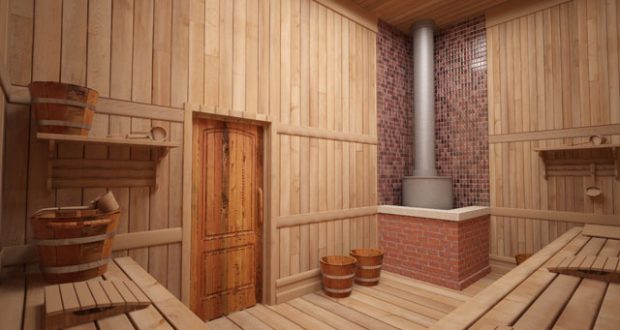

Now let's talk about volume:
- Large companies need the right amount of water. Therefore, a company of 4-5 people needs either an instantaneous water heater or a 100-150 liter boiler.
- One or two people or a group of three people will cost a boiler for 50-80 liters.
- The bathhouse for one "user" is equipped with a 30 liter boiler.
Simply put: before buying a boiler or column, you need to decide on the method of heating the water and the number of visitors to your bath. After that, the optimal version of the water heater will appear as if by itself.
Supporters of sauna pleasures in large companies will undoubtedly be interested in the series
water heaters "Success",
which are tanks with a capacity of 40 to 250 liters, heated from a heating element by 1.5-2 kW.
Water heater "Success" 125 l
The tank is boiled from sheet steel, at least a millimeter thick, and the heating element is equipped not only with a thermostat, but also with a mechanical temperature controller.
Less sociable bath owners will be interested in
model GARANTERM ER 150 V
Water heater GARANTERM ER 150 V
electric boiler for 150 liters, boiling water heating element for 1.5 kW. This dressing can serve a company of 3-4 people who can not only rinse in front of the steam room, but also take a full hot shower. Moreover, the body of the heater, as well as the branch-fittings, are made of stainless steel, and moisture-resistant polyurethane foam is used as a heat insulator.
The cost of the heater is 10-11 thousand rubles.
Well, supporters of budget decisions will like
model Ermak KVS-10-2-90
Water heater Ermak KVS-10-2-90 model
wood-fired storage water heater made of stainless steel with a capacity of 90 liters. Such a boiler boils water with wood, and a heating element with a capacity of up to 2.5 kW. Moreover, this boiler has relatively modest dimensions - the wood-burning firebox is built directly into the storage tank of the heater.
The cost of a stainless steel model is 15,000 rubles.
How can you heat the water in a bath?
- How to heat the water in a bath? How to organize the water supply to the bath?
- How to make a shower in a bath and heat the water in it?
Pressurized plumbing systems, while creating unique opportunities and innumerable conveniences, nevertheless often cause a lot of trouble. For example, if you rarely use the bathhouse, then the water in the tanks and pipes goes out, and the pipes themselves rust.Standing water in pipes freezes in winter and breaks them, and it is very difficult to fill frozen tanks and pipes in winter.
There are several ways to heat water in a bath, the most common of which are: installing a wood or gas water heater and installing an electric heater.
With small volumes of water used, it is convenient (especially in winter) methods of non-pressurized storage of water (in separate closable or open containers, as well as water conduits: overflow waterfalls and open streams). The transport of water in bottles or buckets, as well as the transport of liquids in barrels (cisterns), is not at all a consequence of a low technical level.
If the bath is used only in the warm season, the difficulties with water remaining in the pipes supplying water to it, or in the tank, are solved quite simply. The water is drained before frost, and the bath remains dry for the winter. As soon as the temperature rises, they begin to exploit it: a certain volume is driven through the water supply system in order to rinse and heat it, and then use it as usual. A much more difficult task is to establish a water supply for a bath in winter, especially if it is used once a week or twice a month.
How to heat the water in a bath? A question that is appropriate in a country house, where a small bathhouse can also fit. It only at first glance seems quite simple, but in fact, the need for a large amount of hot water requires the application of certain efforts to build the necessary structure. In principle, a heater for a sauna or bath can be purchased ready-made and easy to install, but you can solve the problem with your own hands by building a non-standard water heater for a bath, for example, on wood.
Heating features
The problem of most baths in a country or country house is the lack of hot water supply, which leads to the need to create systems for heating water. In principle, water heating in a bath can be provided in two ways: separate water heating devices are installed or bath heating stoves are used.
In the first option, various standard hot water boilers can be used, for example, gas heaters or electric heating elements (TENs), which are capable of quickly heating a large volume of water. However, such structures will have to be installed in the washing room, which creates a problem with hot water in the steam room.
The sauna heating stove is capable, in addition to the main function of heating, to provide water heating. In this case, a special tank of the required capacity (from 30 to 100 liters) with water is installed to heat the water, and heat is used, which is still generated to heat the steam room. To maintain the desired temperature, the classic Russian version is used - on the wood. Moreover, the heating principle may be different, but it is desirable to include it in the design of the furnaces already at the design stage.
Advice from the master!
Basically, 3 systems are used: a tank on the stove (or in close contact with it); a tank with a heat exchanger and a samovar tank.
Embedded system
The simplest and most common way to install a water heating tank is to install it on one of the sides or on top of a bath stove. Ideally, a water tank is installed inside the stove and goes out simultaneously into two rooms (steam room and sink). The capacity of such a tank can be any, and the heating method is on wood.
It's another matter if a sauna heating stove has already been built and a tank is not provided in it. In this case, a hinged version is used (usually on the side or in the front in the steam room). The capacity of the tank is about 40-70 liters, and such a volume (on wood) heats up in 1.2-1.6 hours. Heating can be accelerated by insulating the walls of the tank.
You can take water from such a system in different ways.The easiest method is to use a lid on top and scoop up the liquid in a convenient container. A more complex option involves the manufacture of a drain valve - in the upper or lower part, depending on the height of the tank.
If there is a need to bind the tank for heating water to a certain place away from the furnace, then a design with a heat exchanger is used. This design is based on the fact that the heating furnaces have a steel pipe coil inside, through which cold water is supplied. Passing through the oven, the liquid heats up and enters a free-standing container, where hot water is accumulated. The volume of the tank is usually 60-80 liters and heats up within 1.6-2.2 hours.
We offer you to familiarize yourself with: Wood bleach - composition, selection, do-it-yourself production
The heat exchanger uses a well-known physical law - the cold mass goes down, and the heated liquid is fed up. This determines the placement of the tank. The main advantage of the heat exchange system is that there is no need to tie the tank to the furnace. The downside of the heater is its more complex design.
The heater can be built on the chimney, and heating will be carried out from the smoke leading upwards. Such a heat source can be heated to temperatures above 500 ° C, which can be used profitably before the smoke goes into the chimney. The main design problem is to ensure the tightness of the place where the chimney enters the heating tank.
The use of cement mortar is not recommended due to its cracking under such thermal loads.
The main advantage of the "samovar" system is the use of uselessly leaving energy for the benefit of business. In addition, a sufficiently high location of the tank makes it possible to use it as a shower, if you install a suitable water spray.
The big drawback is the complexity of the design and more difficult water filling, taking into account the height of the top cover.
Choice of materials
The choice of material for the heating tank only seems simple. The most common option is steel. The main advantage is low cost and ease of manufacture using conventional welding operations. However, under the conditions of a Russian bath at a constant high temperature, high humidity and exposure to superheated steam, this material quickly rusts, and its service life is short.
Another option is cast iron. In a cast-iron container, the water heats up for a long time, but it cools down for a long time, which makes it possible to keep heat even after stopping the furnace. Disadvantages are heavy weight, high price and corrosion problems.
The best option is stainless steel. Of course, it is much more expensive than ordinary steel sheet, but it does not corrode and can last for many years. The most common steel grades for the manufacture of bath heating tanks are 8-12X18H10 (304) and 08X17 (430). Stainless containers are light enough, have excellent thermal conductivity, and the coefficient of deformation during sharp temperature fluctuations is negligible.
In principle, it is possible to use ready-made enamelled tanks. However, such containers are good as long as the enamelled protective coating is intact. When the slightest chips appear, active corrosion begins. This means that enameled tanks require extra care during operation, which is very difficult to ensure.
The question of how to heat water in a bath is decided independently, based on specific conditions. The easiest option is to install a standard tank heated by heating elements and manually deliver it in small containers to the destination point.
The more traditional way is to use the energy of an already supplied sauna stove. Which option to choose depends on the owner of the bath.
Hot water in the bath with your own hands: schemes
The presence of water in the bath significantly increases the comfort of taking water procedures and facilitates the preparation of the bath.In addition, there is no need to allocate special places in the premises for containers for water, there is no need to periodically fill these containers with water.
Carrying water in buckets is hard and is no longer relevant
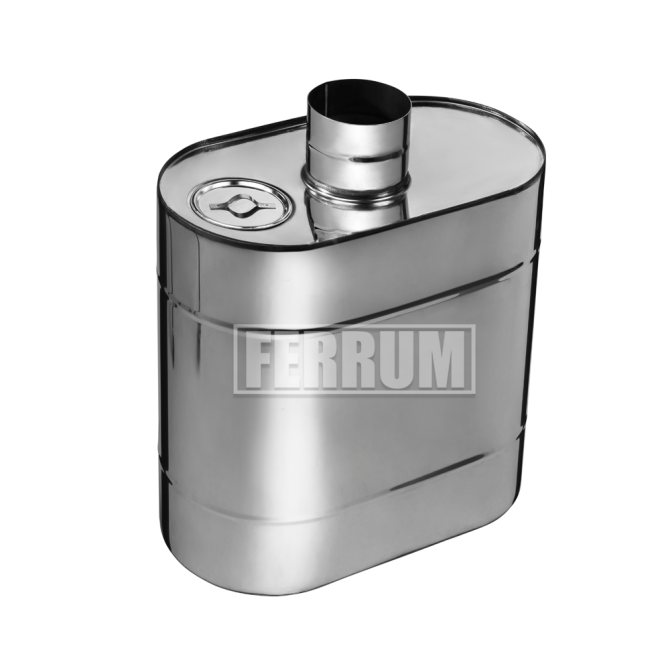

In the absence of running water, the barrels are filled with water with a reserve, the surplus after the bath is poured onto the floor, otherwise it will freeze in winter and the ice will damage the containers, and in the summer, as a result of long standing water, various microorganisms and bacteria multiply in it - the water acquires an unpleasant color and smell.
There is another plus of the water supply in the bath - the amount of water poured out under the bath is significantly reduced, and this is always a problem for wooden structures and foundations.
Water supply in the bath is convenient and economical
How can you lead water into the bath with your own hands, what equipment is required for this and what construction work should be done? To make the best decision in each specific case, you should familiarize yourself with the existing types and schemes of water supply for the bath.
Types of water supply
Depending on the frequency of use of the bath, the water supply can be summer or all-season.
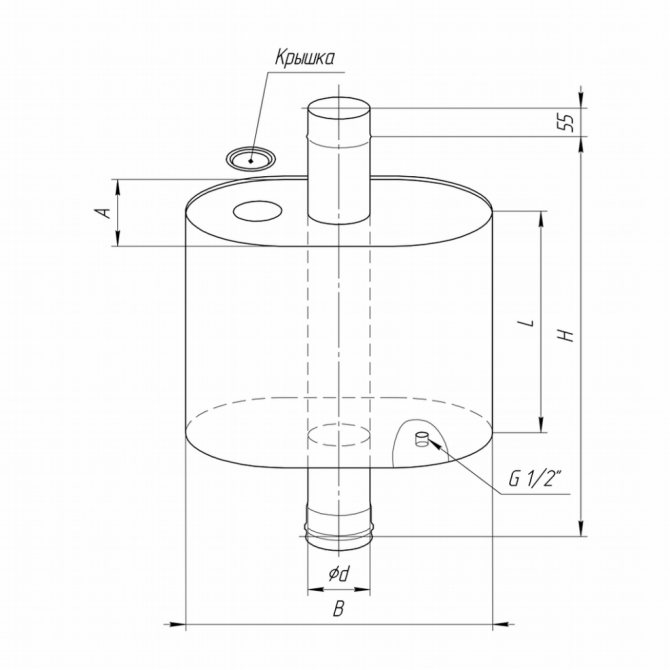

The need for hot water during washing procedures exists at any time of the year. It is possible to ensure its presence in the bath, using, in addition to the old-fashioned method with a heater-stove, with the help of modern technologies.
Important! The choice of a specific method and equipment is due to the peculiarities of the site layout, the availability of utilities, and the seasonality of using the bath.
Such a decision requires the fulfillment of a number of conditions. The main factor is the ability of the existing equipment to provide sufficient heating of the water. For example, the performance of a gas boiler may be insufficient, since the consumption of water in the bath sometimes significantly exceeds the need for it in the house.
The rationality of using such a scheme must be considered taking into account the required length of communications - a large distance between buildings may require the use of a pump, which increases operating costs. It is also necessary to estimate the costs of laying a water supply system from the house - in principle, it is carried out in the same way as supplying cold water.
This is the most common heating method using an oven or various types of heating equipment. In these cases, hot water is produced directly on site and is not required to be transported from another point on the site.
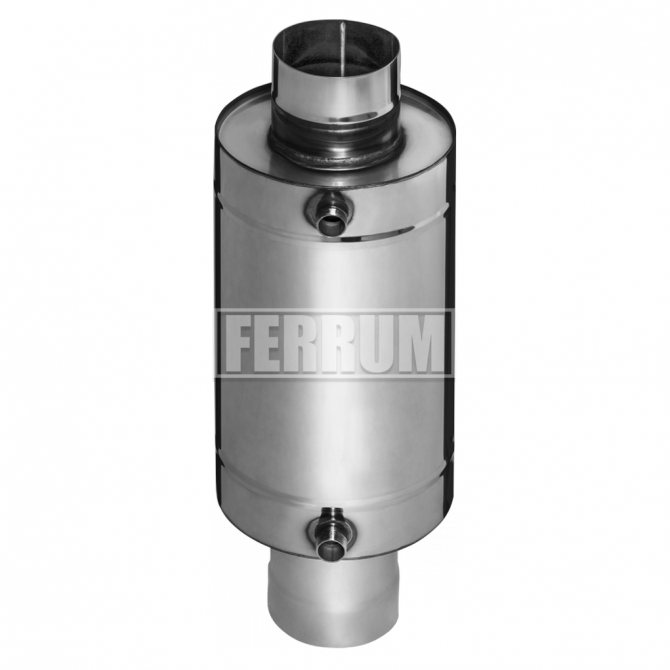

Advantages of installing water heaters:
- No need for a storage tank for hot water;
- The ability to install equipment in any convenient place;
- Autonomy of the use of the steam room and shower;
- The ability to adjust the temperature of water heating.
Advice! The most rational option is the device of a combined water heater with a heat exchanger in communication with the furnace. This is a versatile solution. The scheme allows separate use of heating by electricity and a furnace, or simultaneously by both heat sources, which significantly speeds up the process.
According to the principle of operation, any heating equipment is divided into two types:
- Flow-through installations increase the temperature of the water as it passes through the heat exchanger. Heating occurs quickly, but the volume of warm liquid in the container is inversely proportional to that consumed. That is, the more water is used when taking a shower, the faster it cools. This type of water heaters with compact dimensions is an excellent solution for small baths.
- Accumulation equipment is characterized by a large volume and, accordingly, dimensions, so it is not always possible to find a place for it in a modest bathhouse. The water is heated slowly, but it will not be possible to use it up quickly.
How to heat the water in a bath?
The scheme of heating water with a help of a stove with a samovar-type heat exchanger.
If in summer hot water is needed constantly, and in winter only when there is a desire to come to the country house and take a steam bath, then how to organize a hot water bath and heat the bath?
- install a wood column;
- install an electric water heater with a large capacity;
- install a gas water heater. connected either to a centralized gasification, or to a cylinder, if there is no gas in the house;
- use the system to heat the water in the tank through the hot water pipe from the heating stove;
- supplement the fourth system with heating elements to heat the water in the tank at a time when the bath is not heated.
All these options are applicable in the summer, and at stable negative temperatures, the water will need to be heated and supplied to the bath right in front of the firebox and drained from all containers and pipes after using the bath.
Installation of a stove-tank for heating water in a smoke bath
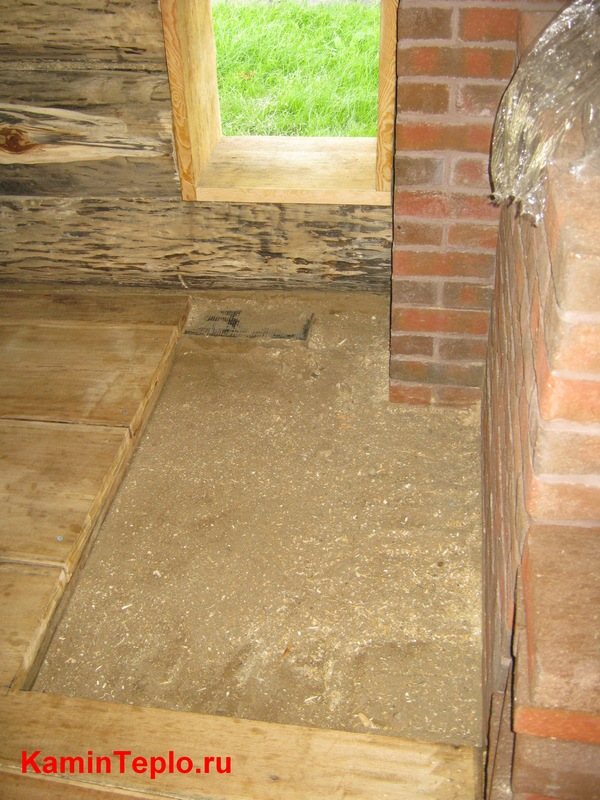

We prepare the base for the stove, we make a hole for the chimney
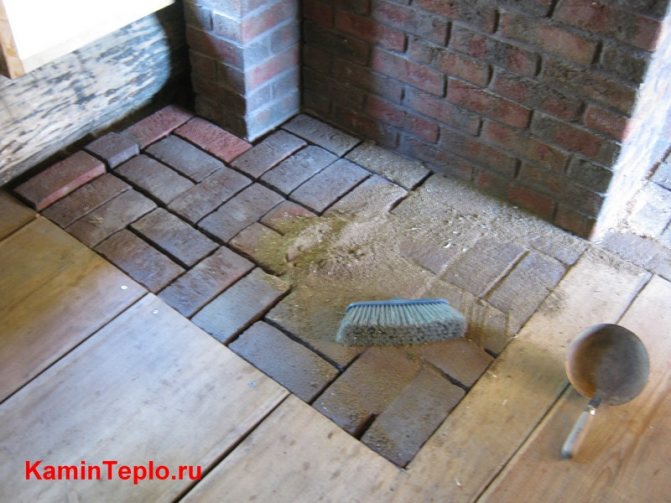

We lay the brick
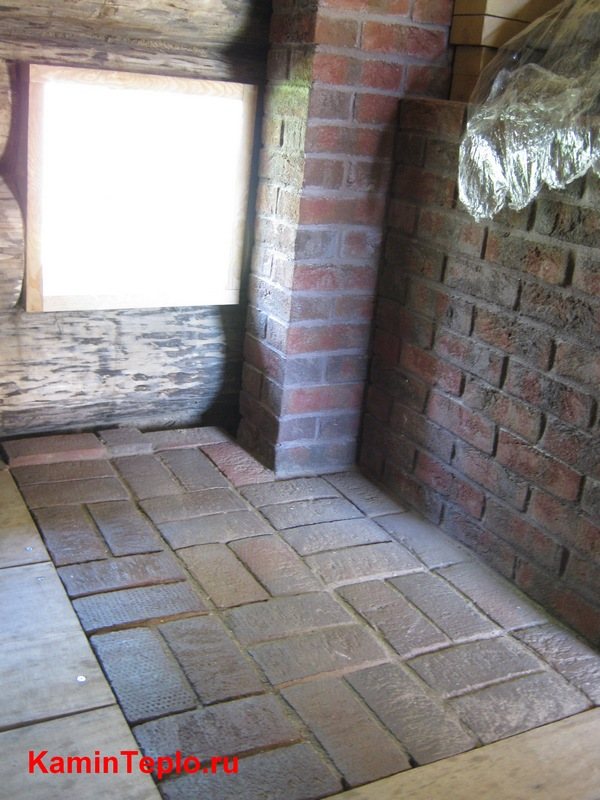

Fill the seams with sand
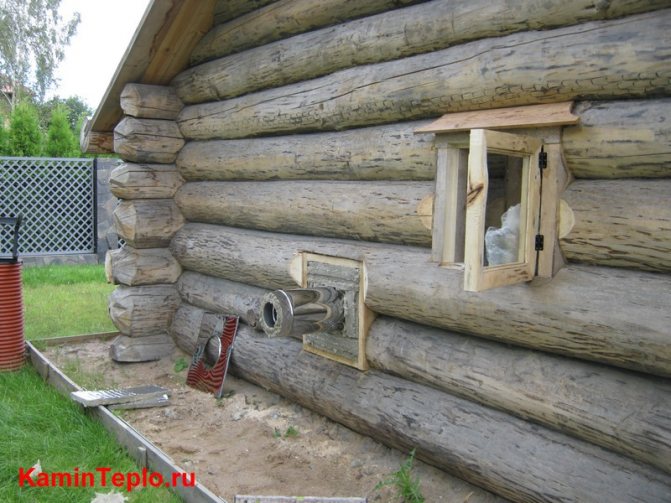

Installation of a chimney for a hot water stove
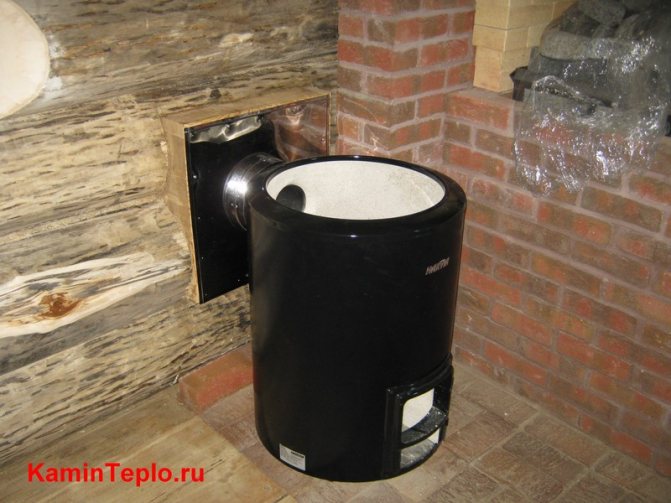

Installing a stove-tank for a black bath
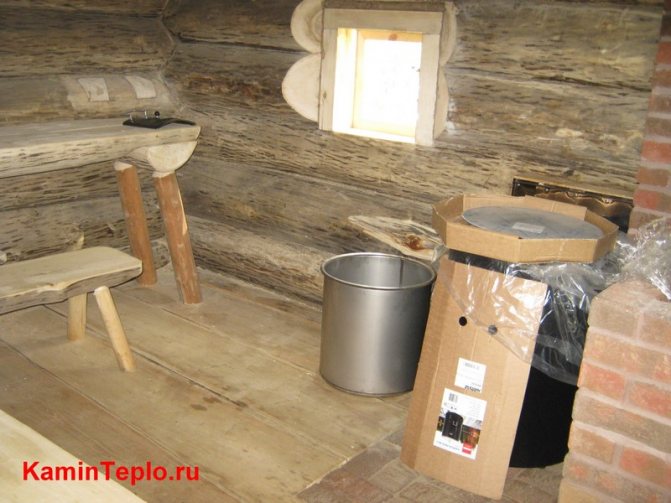

All is ready. There is very little left to fix the fittings and install the tank
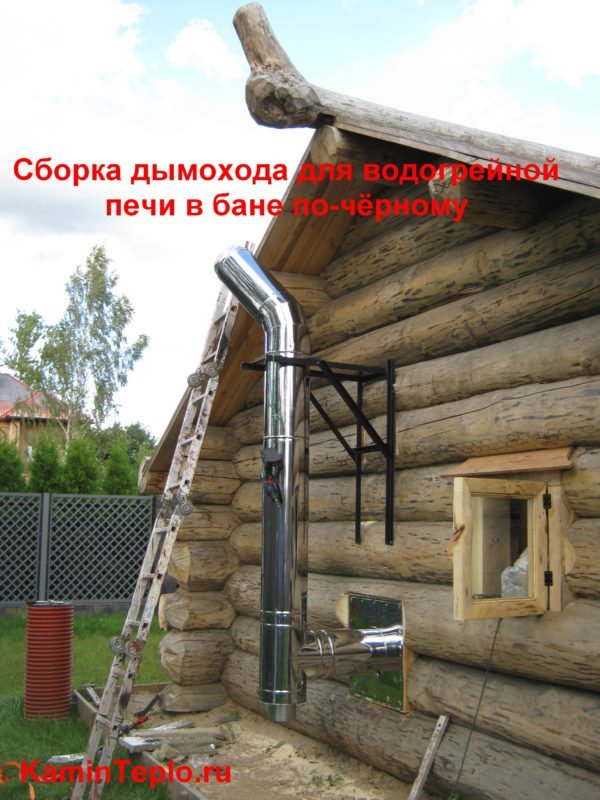

Assembling the chimney for a hot water stove
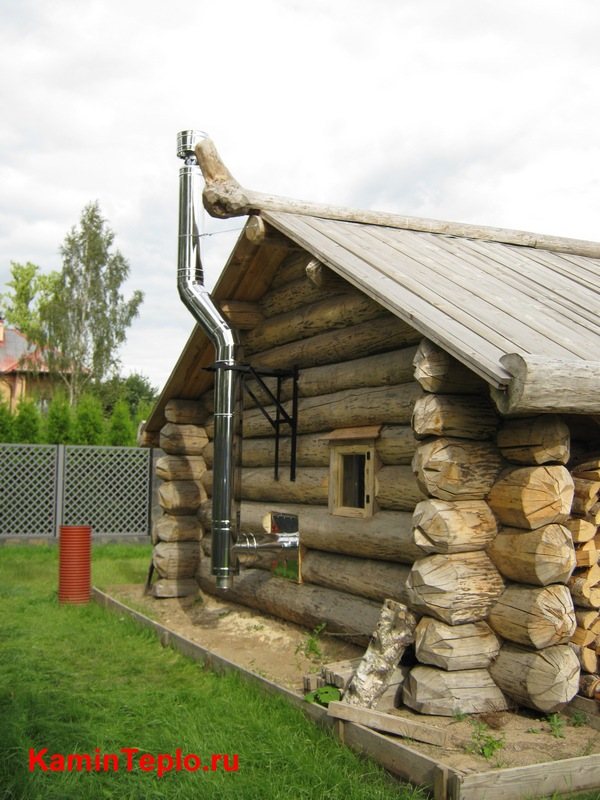

Hot water stove ready to work
Recommendations for use
When installing the stove in a bath with a heat exchanger, heated water will flow into the tank or connected radiators. In the latter case, pipes should be used, which should be wrapped with thermal insulation. The chimney must be led out through a pre-arranged hole in the roof. It is closed with a steel sheet, in which a cut is made. The resulting joints must be well sealed.
If you have chosen a stove for a bath with a heat exchanger for heating, then it is important to take into account that it will be much more difficult to install a water circuit in a firebox or a gas duct compared to the case when the heat exchanger is included with the purchased metal stove. In the first case, the register must be made in advance using a thick-walled black pipe or stainless steel.
If you make a circuit with an insignificant exchange surface, then the coolant will constantly boil, this must be excluded. Whereas excessively large sizes, on the contrary, will cause a long warm-up. Ultimately, the water will remain cool when needed. That is why it is so important to create a circuit with an optimal exchange surface.
To use a heat exchanger in a bath to be really effective, you need to remember a few simple rules.
- It is recommended to use a pump for pumping water. This will help prevent air pockets from forming.
- It is better to connect the heat exchanger to the hanging tank using copper pipes. Brass fittings are suitable for fastening, and materials that are resistant to high temperatures are used to seal the threads.
- The choice of the volume of the water tank depends on the rate of heating of the coolant. It should be remembered that the liquid must warm up at least 2 hours after connecting the entire system.
- Since the pipes will begin to expand as the temperature rises, their fastening must be movable.
- In no case should a heat exchanger be used where there is no water, because the equipment will lose its tightness due to overheating.
- When you create a device for a bath yourself, you should abandon the use of plastic pipes. This is because when heated, they can release toxic substances.
- Before operating a homemade heat exchanger, you must fill the heating tank with water. This cannot be done immediately after lighting up the sauna stove, since the heated heat exchanger may leak due to the temperature difference.
A stove with a heat exchanger is considered an indispensable equipment for any bath.Thanks to such a device, it will be possible to quickly heat the liquid, as well as the air in the steam room and dressing room. The main thing is that the heat exchanger itself is made of high-quality material.
Option 4. We use a water circuit on the chimney pipe.
It is installed by one of the elements of the chimney - chimney-water circuit, it also has two outlet fittings, through which an external tank is connected for heating water. Such a scheme is so working, but as in the 3rd option, it heats the water longer than in the first two.
We consider it also comfortable to use, but less efficient in heating water compared to the first option. In this catalog you can look at such items - water tanks.
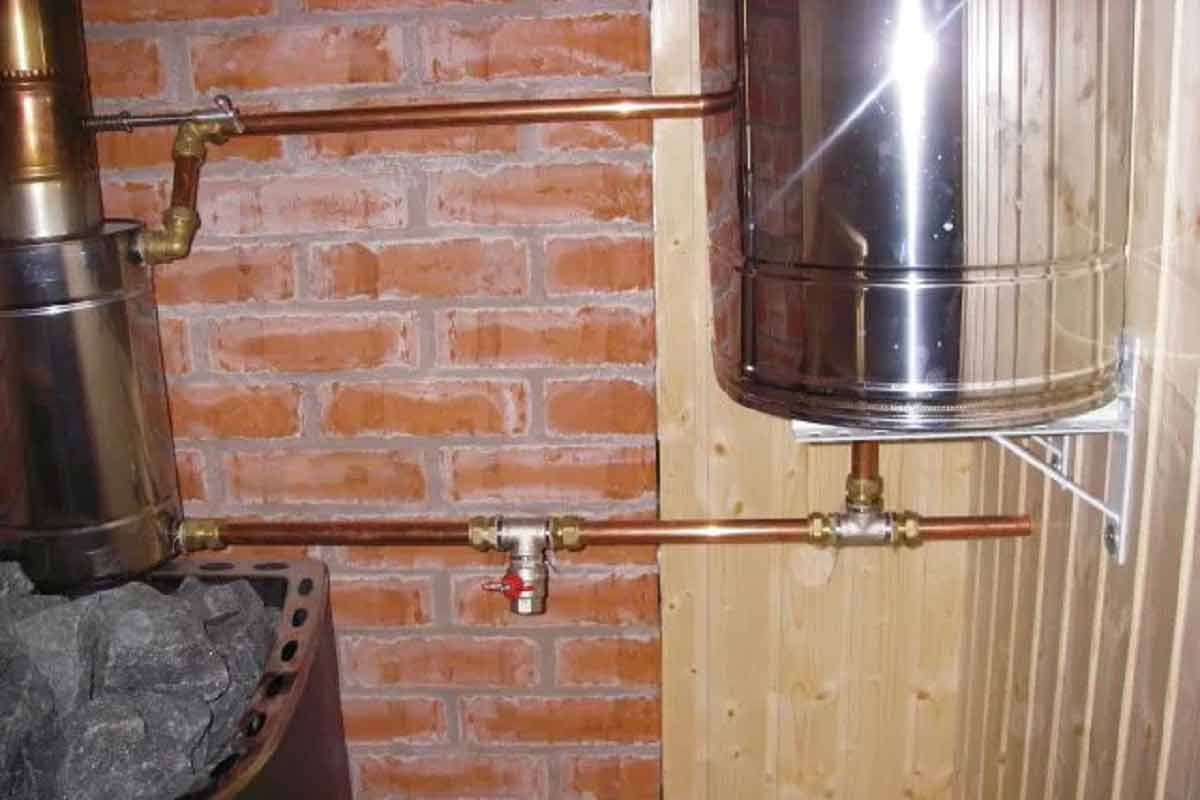

A few words about connection
If you have chosen a stove for a bath with a heat exchanger and a water tank, then you need to understand the point that the design is primarily intended for heating the steam room, the secondary task is to heat the water. It will be impossible to manage multiple processes at the same time. The steam room is a priority.
If the heat exchanger has the form of an economizer or a coil, then it is necessary to install a remote tank in the bath, mounting it above the level of the furnace. For the installation of this system, it is permissible to use metal or polymer pipes, however, polyethylene pipes should not be used. The diameter of pipelines and networks, where water flows by gravity, must be selected in such a way that the indicator is not less than the dimensions of the heater pipes. It is best if the diameter is one size larger. In this case, the step from the tank to the heating equipment should not be more than three meters.
Tube heater
Modern water heaters can be divided into three groups depending on the type of fuel:
- wood-burning;
- gas;
- electrical.
Electrical
There are two types of electric water heaters:
- Flow-through are compact devices that quickly heat the liquid flowing through them. Can quickly dispense hot liquid. In winter, the water is slowly heated, it may not have time to heat up to the optimal temperature, pour cold from the tap or shower.
- Accumulative electric heaters - boilers. Not suitable for small spaces as they take up a lot of space. If the bath is rarely heated in winter, the liquid inside the system may freeze. This will damage the boiler.
To prevent water from freezing in the storage electric heater, you can:
- Install the boiler and turn on the minimum temperature mode. The disadvantage is the extra cost of electricity.
- After each use, drain all liquid from the device.
It is better to install the boiler in rooms with constant heating.
Wood burning
If there is no electricity or gas, the only way to get hot liquid is to use a wood-burning heater. It consists of four elements:
- metal case;
- chambers for solid fuel combustion;
- chimney for removing gases;
- containers with liquid located above the firebox.
We suggest that you familiarize yourself with: Bath after the flu: is it possible to go to the bathhouse or sauna after the flu, the benefits and harms
You can heat a wood-burning stove with different types of firewood. It is necessary to regularly clean the chimney, combustion chamber from soot and ash.
Gas
Gas heater is a flow-through column that operates on natural or liquefied gas. This is an economical equipment that works equally well in winter and summer.
Disadvantages of gas water heaters:
- expensive and complicated installation;
- to connect to the central gas supply system, you need to draw up a lot of paperwork.
To install a gas pipeline, a large amount of land work needs to be done.
Advice from the master!
Advice from the master!
Embedded system
Advice from the master!
Advice from the master!
Any bath requires hot water in it. In the old days, hot water was supplied by concurrent heating of water when the bath itself was kindled: in a boiler built into the stove, in buckets placed nearby, etc.But in our time, when planning a bath, we want to get more convenience and pleasure from bath procedures.
This assumes the presence of a shower, hot water from the tap, and not just washing from buckets. In addition, the simultaneous heating of water, stones and the room requires a carefully balanced degree of heating by the stove. It often happens that the stove needs to be heated for a strictly defined time, otherwise the water starts to boil or the stones do not heat up enough.
The ideal option is a sauna, divided into a washing and steam room with the possibility of firing the stove from the dressing room and with water heating independent of the heater. Such a water supply for a bath is possible in different ways: from a second stove specially for water to connecting to the water supply of a house with a gas boiler or centralized water supply.
When the bath is located next to a residential building, country or country house, which are already provided with hot water supply. the easiest way is to simply run the plumbing out of the house. Of course, this case has its own nuances. If the house is not connected to the gas main and the water is heated in it by electricity or other methods, then such a connection will lead to an unjustified overspending of electricity and other resources, while in the bath itself the heat from the wood will be useless to "fly into the chimney."
Heating water in a bath from a stove can be organized in several ways. This is a container built into the furnace, when part of the wall or bottom of it is brought into the firebox. This is a heat exchange pipe, also brought into the firebox, when the container itself is built-in or separately from the furnace and does not come into contact with an open flame in the firebox. Often, containers are installed on the chimney of the stove inside the bath or taking them out of the ceiling.
In such cases, it is important to correctly design the oven and the location of the container in order to simultaneously achieve the required degree of heating of the stones and prevent water from boiling or insufficient heating. It should also be borne in mind that with increased water hardness in a particular area, a heat exchanger in the form of a pipe in the firebox will quickly grow from the inside with a layer of scale, which will lead to its overheating and burnout and a decrease in water heating performance. For a tank built into a stove or on a chimney, this is not so scary, since the heating and heat transfer area there is tens of times larger.
If the total area of the entire bath allows, then planning a separate stove for hot water supply can be a good option. The convenience of this method is that you can heat the stove-heater depending on the desired temperature, the number of people and the length of stay in the bath.
In turn, a separate stove for water, in addition to allowing the preparation of any required amount of hot water, is very convenient for frequent heating. You can wash and take a shower after staying in the country at any convenient moment, and if you connect an outdoor shower to this container, then there will be no excess moisture inside the washroom in the bath, which will subsequently dry out for a long time without firing the main oven.
Now the most interesting thing: how can you provide hot water under pressure in a separate bath so that the shower stall works normally and water of the required temperature flows from the mixer. It is important that the visit to the bath was as comfortable as possible and there would be no need to fiddle with ladles and basins to prepare water of the required temperature.
If no communications are connected to the bath, it will be difficult to organize hot water supply, it is possible to install a container with hot water as high as possible above the ceiling. This will provide the possibility of using the mixer, but will not provide a full-fledged shower, only under a slight pressure, like a simple summer shower. In addition, you will have to drag buckets of water upstairs to fill the hot and cold water tanks.
often they only provide a head of water for lifting only a little more than one meter.There are also systems for providing the required water pressure, which include a pump and a small hydraulic accumulator. They are able to maintain a given pressure at the outlet even when connected to conventional tanks located in the "traditional" way - in the bath itself.
In the case when a cold water main is connected to the bath, hot water supply for the bath can be organized using the pressure of this main itself. The author came across an option when a used large-capacity electric water-heating boiler with a burned-out heating element was used.
With the help of a simple system of taps and a supply system, hot water, after heating in a tank built into the furnace, fills the water heater by gravity, which is then switched with taps to the cold water main. After that, it is used as a regular domestic water heater until the hot water is completely replaced by cold water.
If you wish, if you are not afraid of the significant consumption of electricity, you can connect a working water heater in the same way, but this is a very uneconomical method, since the heated remaining water will cool down during a significant break in using the bath, and the electricity will be wasted.
Another way to heat water is a heat exchanger in a hot water boiler. The water is heated in the usual way to a high temperature in the boiler. There is a heat exchanger in the boiler. It can be in the form of a radiator like a car, or a radiator from a gas boiler. The simplest in execution is a pipe coil.
It is rather difficult to accurately calculate the performance of such a heat exchanger: the calculation for the pipe-in-pipe method gives a performance of about 20-50 ml per second for one meter when the water is heated from 15 C to 40-50 C at a boiler temperature of 55 to 95 C. This is not enough, but let us remind you that this is for one meter.
The heat exchanger shown in the photo uses only 5 meters of pipe, but this particular stove brings the water almost to a boil by the time the bath is ready, which makes it possible to fully use the shower. The disadvantage of this method is a gradual decrease in performance, which makes it necessary to adjust the mixer towards hot water, and in the end it will be necessary to reduce the pressure.
When using various heat exchangers located in a hot water boiler, it should be remembered that, although the capacity is not quadratic, it depends on the temperature difference, the larger it is, the more productive, i.e. it is better to heat a little less water in the boiler, but to a higher temperature.
You are on the portal about the repair of apartments and houses, you are reading the article "Hot water supply for a bath." You can find a lot of information on our website about design, materials for renovation, remodeling, electrical, plumbing and much more. Use the search bar or sections on the left for this.
There are also many interesting videos about apartment renovation on the site.
Advice from the master!
Advice from the master!
Important! The use of gas boilers requires strict adherence to safety regulations. Installation and operation of equipment with a power of more than 50 kW is associated with the mandatory receipt of additional technical conditions and permits.
Electric water heaters are available in two types:
- Flow-through type with an optimal performance of 2.5 l / s. The equipment heats the water as it moves, using the largest amount of electricity.
- DHW cylinders with an optimal volume of 100 liters. They consume significantly less electricity. The water is heated for 3-4 hours, after which its temperature is kept constant.
In order to save energy and make it possible to use the shower in the sink at any time, a combined system is used.It consists of a stove and an electric water heater, which can work simultaneously to quickly heat a large volume of water, or separately, depending on the current need.
Instantaneous water heater for a bath
The bath always requires warm or hot water. Providing a bathhouse with a water supply system is a matter that requires a responsible approach with a thorough study of the nuances of the structure, its location, frequency of use, etc. Often this aspect of water supply is solved by purchasing a boiler for a bath of a certain design, method of functioning.
Many cannot imagine a country cottage or cottage without a bath. Of course, it's great to douse yourself with ice water from a tub, but this is just one of the bath procedures.
You will need hot water to wash before and after using the steam room. Heating water in the house and carrying it to the bath in buckets is clearly not the best way out.
The best solution to the problem is to install a water heater for the bath.
A hot shower in the bath is a must
The water supply system in the bath must meet the following conditions:
- Even if we are not talking about a summer residence, but about a country house where they live permanently, the bathhouse, as a rule, is not heated and is not used every day, therefore, the water must be drained from the water supply system, in order to avoid its failure due to freezing.
- The design of the water supply system for a bath should be as simple as possible, because you will most likely have to carry out all operations related to operation and repair yourself.
- The device used to heat water in the water supply system must be equipped in accordance with fire safety requirements.
The heart of the bath water supply system is a water heating device, therefore, its choice should be approached with all responsibility. Taking into account the specific conditions in which the water heater is used, the requirements for bath water heaters are as follows:
- The work of a bath requires a large amount of water, therefore the use of instantaneous water heaters (gas water heaters, electric "flow pipes") is impractical, it is better to give preference to electric water heaters or boilers.
- A boiler for water supply to a bath should not have a tank of too large a volume, because the larger the volume of the water tank, the longer it takes to heat up. If you "overdo it" with the volume of the tank, then you will have to wait two to three hours for heating the water to a suitable temperature.
- Draining water from the boiler tank should be simple and convenient. It is better to provide a drain directly into the sewer system, otherwise you will have to run around a lot with buckets.
- It is better to choose a boiler model for the bath, which ensures that the positive temperature in the tank is maintained in "standby mode". This will allow you to use the bath on weekends without draining the tank overnight.
- Please note that the heater model you have selected is equipped with a thermometer. The absence of such a trifle can cause a lot of inconvenience in the future.
The undeniable advantage of water heaters using natural gas as an energy source is the sensitive cost savings. The operating cost of a gas heater may differ from the operating price of an electric boiler by three to four times.
However, the use of a gas water heater requires compliance with an important condition - access to the gas main. In addition, the installation of a gas heater requires approval from the local gas service.
If there is no gas pipe nearby, or you do not want to dive into the abyss of bureaucracy, then there is only one option left - an electric water heater.
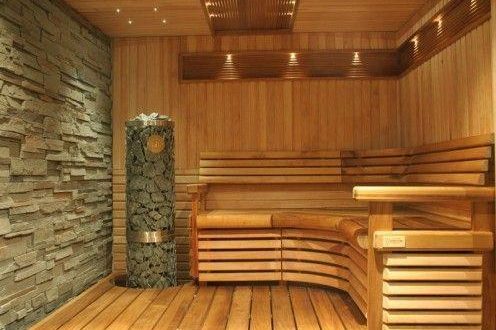

Assortment of boilers in the store
Boiler design
The design of electric water heaters is simple - they represent an electrically insulated container for water (boiler), inside the volume of which there is a tubular heating element - a tubular electric heater. A special anode device prevents the formation of a layer of rust on the boiler wall.
Usually, water heaters are equipped with thermostatic devices to automatically turn off the heating element when the water temperature reaches a predetermined level. The same device will reconnect the electric heater when the water temperature drops below a certain limit.
Thus, energy is saved and the water temperature is maintained within the specified ranges.
Also, boilers are equipped with a safety valve that protects the container from being destroyed by excessive pressure.
The principle of operation of the storage electric heater is such that it requires the tank to be filled with water, since the water intake is carried out from the top of the tank, where hot water rises according to the laws of physics.
We suggest that you familiarize yourself with the insulation of the bath foundation with penoplex
Device power
As a rule, a water heater with a capacity of 1.5 - 2.5 kW is enough for a bath, for which a single-phase power supply is suitable. The power requirements for a low-power boiler also do not differ in any special conditions.
You will need a separate cable from the switchboard and a circuit breaker. It is also imperative to install a residual current device (RCD), which will save the bath visitors from electric shock.
Connecting the boiler to an outlet is not allowed, and it is not provided for by the design. The power cable is connected to the contacts inside the boiler body.
When choosing a heater model, it is necessary to take into account the need for water. Water consumption depends on the number of people who will use the bath. The boiler volume of the heater must provide the required amount of water with a margin of at least 20%, however, the volume of the tank must not be excessive.
Large and powerful water heater
If the homestead has a sufficiently powerful hot water supply and heating system, you can use an indirect heating boiler in the bathhouse. In indirect heating boilers, not a heating element passes through the volume of water inside the boiler, but a pipe with a coolant from the heating system.
Accumulative water heaters for a bath are not as demanding on water as flowing ones, however, if you want the water heater to serve you long enough, ensure the proper water quality using filters and water softeners.
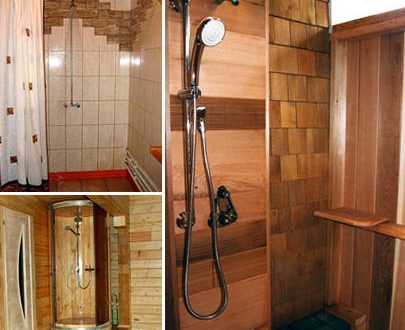

If you choose the right model of the electric heater, correctly comply with all the connection requirements and do not neglect the quality of the water, the heater will serve you for at least 10-15 years.
The simplest is the case with water heating, if it is possible to connect to the gas main, in this case, you can install a flow-through gas water heater. In this case, 3-4 times less money is spent on heating water.
Gas instantaneous water heater for a bath
But there is one significant "but" - you need to order a project, coordinate it, which is quite troublesome, and specialists are needed to connect a gas water heater, and bringing them to a summer cottage can be problematic, or, in any case, costly.
You can equip a metal or brick oven for a bath with a water heating tank - hinged or remote. But there are also problems here: the water in such tanks boils faster than the air in the steam room heats up.
To prevent raw and heavy steam from coming out of a container with boiling water, you have to constantly monitor its temperature, draining hot and pouring cold. These dances with buckets quickly become boring, especially if they are often steamed.
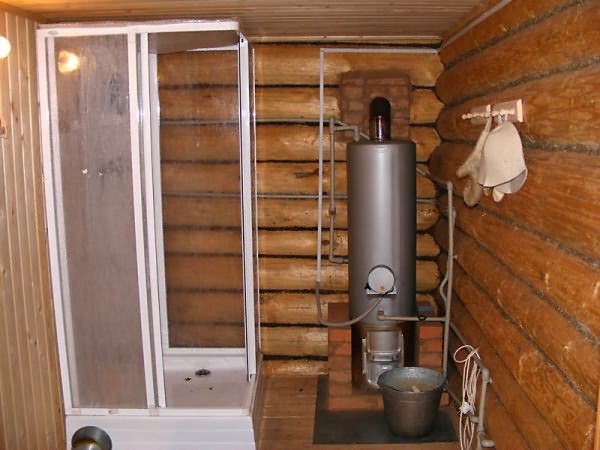

And the pleasure is not the cheapest:
- If you take a good tank for a pipe, you will have to spend about $ 170.This option has an additional plus: you use the heat to heat the water, which usually, in the literal sense of the word, flies out into the pipe.
Sauna water heater on a pipe from the heater
In addition, the temperature of the chimney above the water tank is no longer so critical - most of the heat is given to heating the water. It is easier to pass such a cooled chimney through the ceiling and roof.
- Buying a remote water tank and a heat exchanger (register) in the oven (they must be compatible with your oven) will cost about $ 200-250.
Remote tank installation diagramInstallation of such a system is not too complicated, but it has its own peculiarities.
- All the charm of buying a hinged tank in just those settings: just hung it on one of the walls of the stove and use it.
A hinged oven tank is simply hung on one of the wallsIn addition, it will cost less, but there are some nuances - the water heats up rather slowly, but if the stove is installed in the steam room or is heated from the outlet (i.e. its main part is also in the steam room), then the tank will also have to be hung in the steam room, which will lead to the formation of heavy vapor.
So the tanks for heating water on the stove are quite simple, but not the best option. But this method is almost the only one if there is no water supply system in the bath and there is no (at least for now) the possibility of organizing it: you can pour water from a bucket into a hinged tank without being tied to the system.
Note that almost all manufacturers of sauna stoves have models with a water tank.
Electric water heaters are quite popular in baths. But here, too, opinions differ: someone is for flow-through models, someone is more comfortable with accumulative ones. Flowing ones are good because they quickly heat water, and, with sufficient power, they can deliver water at a high temperature.
But not every dacha has the ability to consume large powers: in most cases there is a limitation of 4-6 kW, but this includes all electrical appliances.
The power of 1.5-3.5 kW, which most summer residents can afford, will be enough to heat water in the autumn-spring period, but you will not get hot water in winter, or you will have to go to some tricks.
Instantaneous electric water heater for a bath or sauna
You can raise the temperature by lowering the pressure, but the water is still warm. You can rinse with it after visiting the steam room, but you will not be able to fully wash yourself - it is too cold.
You can increase the outlet water temperature if you put taps at the inlet and outlet of such a water heater.
Built-in tank
Traditional water heating
Usually a brick or metal stove is installed in the bath, where the combustion of firewood is used as fuel. The advantage of the method is the possibility of periodic heating, just before taking the procedures, the disadvantage is the long heating time.
The easiest way is to install a cast-iron plate above the firebox, on which to place a metal tank with a lid. Such a removable container is easy to descale, but there is a risk of getting burned against its walls. To avoid the need to pour boiling water during a prolonged heating to reduce humidity from steam in the room, a drain valve is installed in the tank. Otherwise, the installation of external additional capacity is required, which reduces the mobility of the device.
The tank can be built into the oven. which complicates repair work when damage to its body is detected. It is more rational at the masonry stage to provide for a special recess in the structure, inside which to install a water tank. The tank can be located on the wall near the stove, provided it is sufficiently heated, otherwise the process will be too long.
Advice! When using brick ovens, to prevent the penetration of carbon monoxide into the room, it is necessary to wait for the firewood to completely burn out.
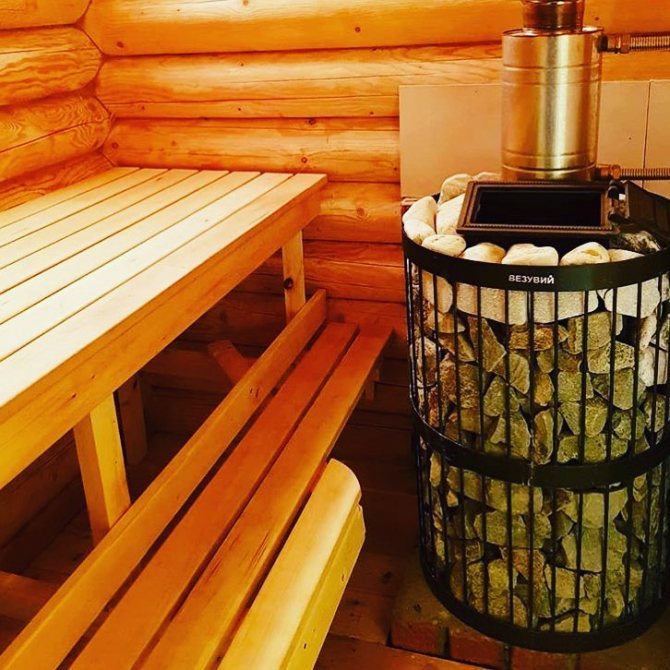

The best option is the option of installing a heat exchanger, which can have a very different design.The simplest device is a U-shaped pipe section or a section of a cast-iron battery. A heat exchanger in the firebox connects the stove to the tank. The dimensions depend on the volume of water, its initial temperature, the power of the oven and the desired heating time.
This type of water heating equipment has gained great popularity due to a number of its advantages:
- Compact dimensions;
- High speed of water heating;
- Significant fuel savings;
- The ability to adjust the temperature of air and water;
- Large volume of heated space.
The disadvantage of metal ovens is their rapid cooling.
Important! Due to the protection against depressurization of the chimney and the combustion channel, carbon monoxide cannot seep into the room, therefore it is possible to continue heating during the bath procedures.
The stove is installed between the steam room and the washing room, as if it is mounted in the wall between them. The water heating tank is made of 2 mm thick stainless steel sheet. Its installation is carried out on the wall of the washing room. Additional heating of the tank is provided by brick lining of the wall around the furnace. Communication between the elements of the system is arranged using a heat exchanger. The tank for circulating boiling water should be located above it. The container at the bottom has a tap, and in the lid there is an opening for water intake and topping up.
The system allows you to have a year-round production of 100 liters of boiling water. The temperature is controlled by changing the draft in the firebox. The position of the wood in the oven makes it possible to adjust the direction of heating. Stacking fuel near the wall heats the air in the steam room, closer to the door - water. Before the firebox, the container is filled to a certain level, the circulation of boiling water begins when the furnace is heated.
Option 2. We use a stove with a water tank
We are buying a stove with a water tank (look at the catalog of a stove with a water tank). All manufacturers also make modifications to wood-burning stoves with a tank. We pour water into the tank and it heats up in the same way usually in an hour from the firebox.
The disadvantage of this option will be the following moment: you will have to get water out of the tank either from above with a ladle or by substituting some kind of container down into this tank to the drain cock, and it, as a rule, is near the floor. In both the first and second cases, you will have to carry out manipulations near a hot stove with boiling water, which is not comfortable and safe to eat.
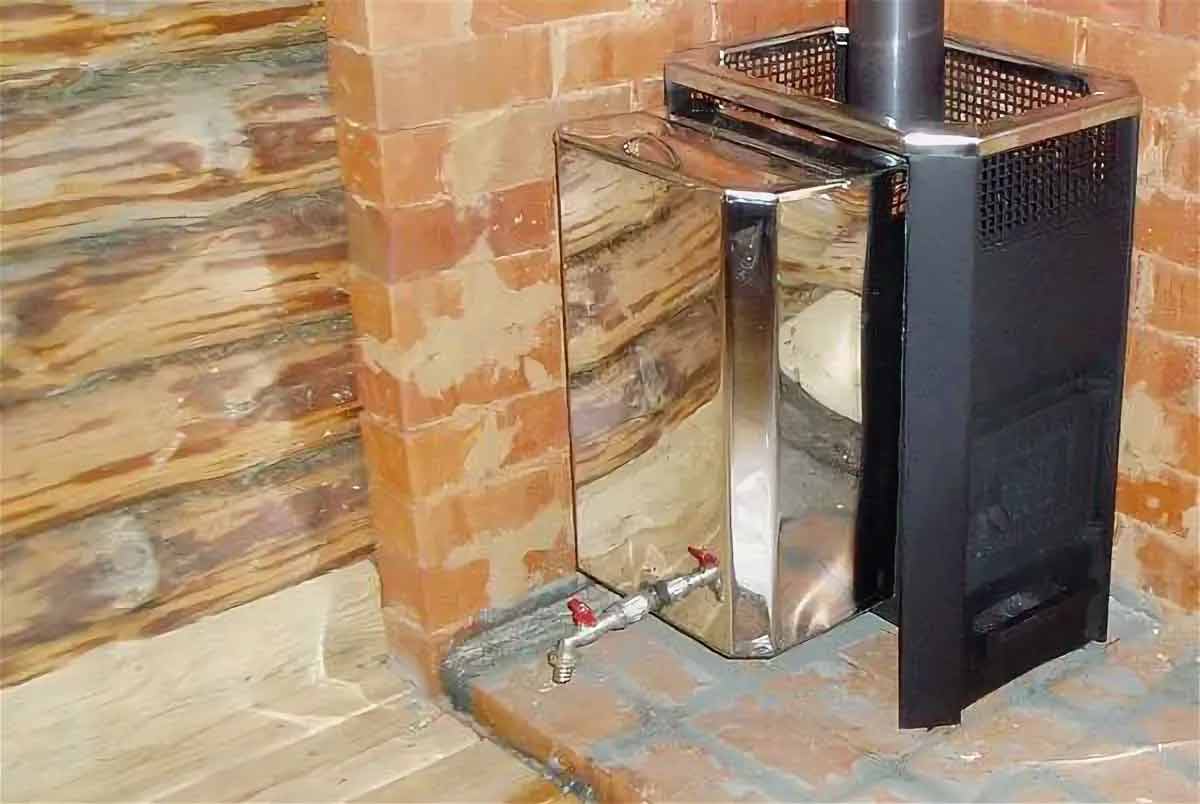

Description and types of heat exchangers
Sauna stoves with a heat exchanger are a structure with a space for cold water. Here it heats up, and then is transferred through pipes to a hinged tank or radiator. It should be noted that such a device helps not only to heat the water for the washing room, but also to provide an optimal microclimate in the dressing room.
All heat exchangers for a bath are divided into two groups.
- Internal. We are talking about a tank or a coil, which is located between the body of the sauna stove and the internal firebox. This item is sometimes referred to as a shirt. It is to it that the external tank is connected. Installation will not cause any difficulties, but if necessary, removing the device will not be easy. In this case, much depends on the design features of the sauna stove.
- External. These are heat exchangers of the samovar type. A chimney pipe is provided here, connected thanks to fittings. This option is considered optimal for the oven, because it provides more convenient maintenance. In this case, the product can be easily cleaned from the formed scale.
If we talk about saving heat, then the external option is considered preferable for the furnace. So, there is a decrease in fuel consumption. because it uses heat from the stove chimney for heating. If we talk about the built-in heat exchanger, then the heating from the firebox is important here. Accordingly, the stones, together with the room itself, may not warm up enough.
It is worth noting the fact that any types of heat exchangers intended for a bath must be filled with water. It can also be antifreeze.A hinged tank is provided for supplying liquid, which is connected using fittings. The operating principle itself is very simple. Functioning is possible thanks to the natural circulation of water. It is also possible to connect an electric pump to the oven.
Experienced builders recommend using open systems in the bath, that is, those options where there is no pressure. The most effective for a sauna stove is equipment with a pipe length of up to 3 m. This is really enough if the tank is located behind the wall of the steam room. The thickness of the pipes should not exceed 1 inch, otherwise, due to resistance, the sauna stove will not be able to move water.
Main advantages
For any baths, it is worth using equipment with a heat exchanger. There are many benefits to this:
- implementation of heating water, as well as air in several rooms at once;
- the possibility of placing the tank away from the furnace;
- durability;
- attractive appearance;
- ease of installation and maintenance;
- high efficiency;
- space saving due to compact size;
- the possibility of installation in a Finnish sauna or an ordinary Russian bath;
- increased power, providing fast heating;
- almost complete absence of deformation during heating.
Outcome
I can recommend this way of heating water in steam baths in a black way: it's convenient, the Harvia stove lasts a long time. I have been using this method of heating water in my bathhouse for over 15 years. I also install the stove in saunas with metal stoves. In Russian steam rooms, where the stones are heated directly by the flue gases, it is also possible to install such a stove in the washing room.
An example of installing a stove in a bath
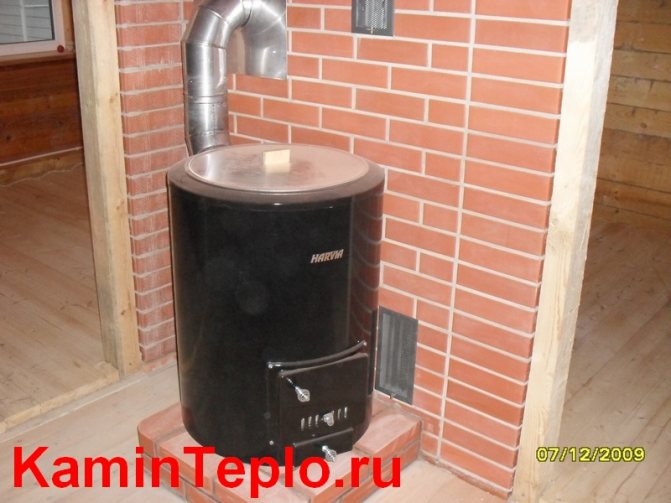

An example of installing a stove-tank for heating water in a bath
The furnace is still operating without repair.
If this article is interesting for you, you can give a link on your page in social networks or put about.
DIY heat exchanger construction
Many people prefer to build such bath equipment on their own. The simplest option is a stainless steel pipe system. Also, if desired, you can use units created by welding from channels.
For a brick bath stove, a simple sheet metal structure would be the best option. So, from a material 2 mm thick, two rectangular and cylindrical tanks are created. These parts are connected using pipes. To ensure the accuracy of the calculations, it is necessary to weld the prepared elements.
When self-erecting the structure, it is necessary to minimize the length of the pipes. This requirement is explained by the fact that heat must be transferred to water as quickly as possible.
If the system does not provide for the presence of a pump, it is worth organizing the system so that cold water itself flows to the sauna stove, and hot water goes to the tank. Accordingly, the pipes must be installed at an angle of approximately 5 °.
It is important to remember that the main disadvantage of a heat exchanger is metal corrosion. This is due to the fact that any metal surfaces are not sufficiently resistant to water and various aggressive substances. Accordingly, it is necessary to protect the equipment. For this purpose, pipes made of steel or copper are used with spraying of certain metals, which will increase the durability of the structure.

